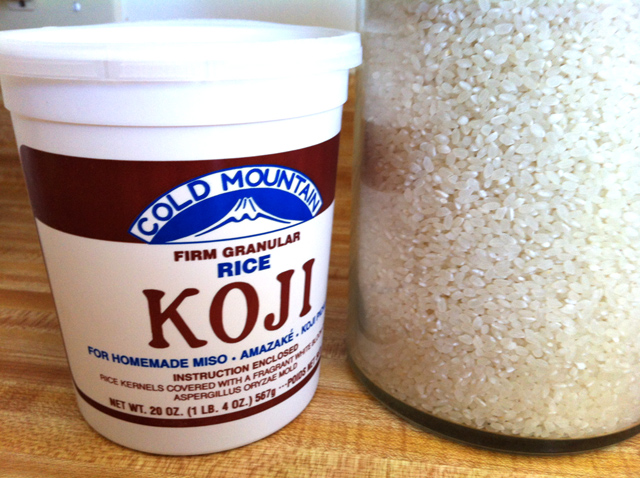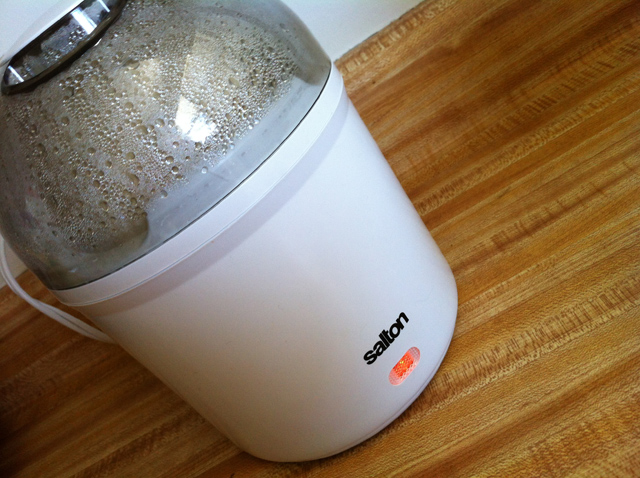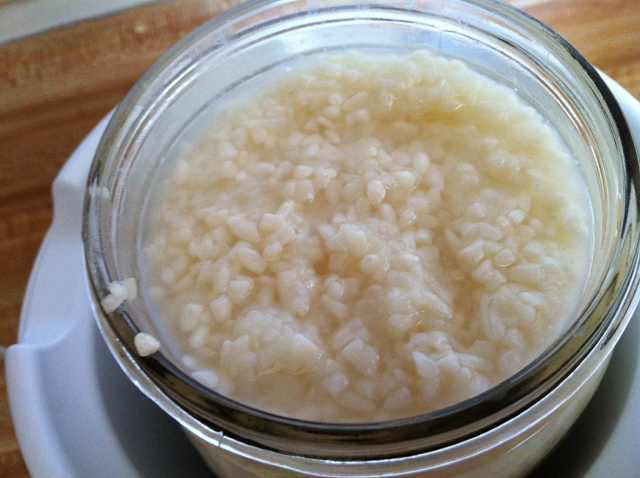 Amazake
Amazake literally translates to "sweet sake" which is deceiving considering it's non-alcoholic. It's sweet, milky and easy to digest, making it perfect for kids or adults with an upset stomach.
Amazake is made by combining koji with cooked rice, which allows the rice to break down into simple sugars. This is the first step to sake-making. After this step, making sake involves fermentation, pasteurization and filteration and achieves an ABV of around 15%. Because amazake never goes through the fermentation process of 3-4 weeks it doesn't contain any alcohol. Amazake is said to be good for digestion because it helps break down proteins and complex carbohydrates. It's also believed to be a good hangover cure. And because it doesn't contain any alcohol, it is served to kids as a celebratory drink for special occasions like Girl's Day (March 3) and New Year's.
Making amazake is simple as long as you have an appliance that can maintain a low, steady temperature of 120-140˚F for up to 24 hours and can buy koji (
aspergillus oryzae) and rice. That said, it took me three tries to make an amazake I would feel proud to serve at our "
Umami Mart Hinamatsuri". (Shameless plug: Please come to Umami Mart this Friday 6-8pm to try my amazake!).
For my first attempt, I used my crock-pot on the "Low" setting, but it ended up burnt to a crisp. FAIL.
Then I remembered I had a yogurt-maker that my friends Laura and Will gave to me over a year ago. Jack pot! I think people also use a cooler with some hot water bottles in it or a dehydrator to maintain that 120-140˚F temperature. Finding the right place to incubate your amazake is probably the hardest part of making this drink. But with the yogurt-maker, I was ready to go. I used brown rice and koji and although it turned out okay, I didn't like how it was a little too rustic-tasting. The rice kernels were too firm and the brown rice over-powered the faint sweetness. That said, amazake made with brown rice has more vitamins than white rice. Sacrifices...
So for my third attempt, I decided to go with white rice. I used the "porridge" setting on my rice cooker then combined it with koji into the yogurt maker. SUCCESS! The result was milkier, sweeter and cleaner tasting than the brown rice trial.
Other applications for amazake include using it as a sweetener (instead of honey) or adding it as a topping to desserts.
So here is my final successful recipe for making amazake.
1 cup short grain white rice
2.5 cups water
2 cups dry koji (I used Cold Mountain brand which they sell at Japanese markets and health food markets -- including Whole Foods, where it will cost you an arm and a leg)

1. Steam white rice to porridge consistency.
2. Set up your low temperature appliance (120-140˚F) by plugging it in or preparing a cooler with hot water bottles.
3. Mix the koji into the rice.
4. Put the mixture into a wide mouth glass jar and place into the low temperature appliance for 14-24 hours.

5. The amazake is ready when the rice grains are very soft and the koji is broken down. The amazake should be sweet and mildly syrupy.

6. To enjoy as a hot amazake drink, add equal parts water and bring to a soft boil. Add some ginger as a topping.

This is a very cozy drink, perfect for when you want to curl up in front of the TV after a heavy meal. It's also gluten-free, vegan and dairy-free!
 Amazake literally translates to "sweet sake" which is deceiving considering it's non-alcoholic. It's sweet, milky and easy to digest, making it perfect for kids or adults with an upset stomach.
Amazake is made by combining koji with cooked rice, which allows the rice to break down into simple sugars. This is the first step to sake-making. After this step, making sake involves fermentation, pasteurization and filteration and achieves an ABV of around 15%. Because amazake never goes through the fermentation process of 3-4 weeks it doesn't contain any alcohol. Amazake is said to be good for digestion because it helps break down proteins and complex carbohydrates. It's also believed to be a good hangover cure. And because it doesn't contain any alcohol, it is served to kids as a celebratory drink for special occasions like Girl's Day (March 3) and New Year's.
Making amazake is simple as long as you have an appliance that can maintain a low, steady temperature of 120-140˚F for up to 24 hours and can buy koji (aspergillus oryzae) and rice. That said, it took me three tries to make an amazake I would feel proud to serve at our "Umami Mart Hinamatsuri". (Shameless plug: Please come to Umami Mart this Friday 6-8pm to try my amazake!).
For my first attempt, I used my crock-pot on the "Low" setting, but it ended up burnt to a crisp. FAIL.
Then I remembered I had a yogurt-maker that my friends Laura and Will gave to me over a year ago. Jack pot! I think people also use a cooler with some hot water bottles in it or a dehydrator to maintain that 120-140˚F temperature. Finding the right place to incubate your amazake is probably the hardest part of making this drink. But with the yogurt-maker, I was ready to go. I used brown rice and koji and although it turned out okay, I didn't like how it was a little too rustic-tasting. The rice kernels were too firm and the brown rice over-powered the faint sweetness. That said, amazake made with brown rice has more vitamins than white rice. Sacrifices...
So for my third attempt, I decided to go with white rice. I used the "porridge" setting on my rice cooker then combined it with koji into the yogurt maker. SUCCESS! The result was milkier, sweeter and cleaner tasting than the brown rice trial.
Other applications for amazake include using it as a sweetener (instead of honey) or adding it as a topping to desserts.
So here is my final successful recipe for making amazake.
1 cup short grain white rice
2.5 cups water
2 cups dry koji (I used Cold Mountain brand which they sell at Japanese markets and health food markets -- including Whole Foods, where it will cost you an arm and a leg)
Amazake literally translates to "sweet sake" which is deceiving considering it's non-alcoholic. It's sweet, milky and easy to digest, making it perfect for kids or adults with an upset stomach.
Amazake is made by combining koji with cooked rice, which allows the rice to break down into simple sugars. This is the first step to sake-making. After this step, making sake involves fermentation, pasteurization and filteration and achieves an ABV of around 15%. Because amazake never goes through the fermentation process of 3-4 weeks it doesn't contain any alcohol. Amazake is said to be good for digestion because it helps break down proteins and complex carbohydrates. It's also believed to be a good hangover cure. And because it doesn't contain any alcohol, it is served to kids as a celebratory drink for special occasions like Girl's Day (March 3) and New Year's.
Making amazake is simple as long as you have an appliance that can maintain a low, steady temperature of 120-140˚F for up to 24 hours and can buy koji (aspergillus oryzae) and rice. That said, it took me three tries to make an amazake I would feel proud to serve at our "Umami Mart Hinamatsuri". (Shameless plug: Please come to Umami Mart this Friday 6-8pm to try my amazake!).
For my first attempt, I used my crock-pot on the "Low" setting, but it ended up burnt to a crisp. FAIL.
Then I remembered I had a yogurt-maker that my friends Laura and Will gave to me over a year ago. Jack pot! I think people also use a cooler with some hot water bottles in it or a dehydrator to maintain that 120-140˚F temperature. Finding the right place to incubate your amazake is probably the hardest part of making this drink. But with the yogurt-maker, I was ready to go. I used brown rice and koji and although it turned out okay, I didn't like how it was a little too rustic-tasting. The rice kernels were too firm and the brown rice over-powered the faint sweetness. That said, amazake made with brown rice has more vitamins than white rice. Sacrifices...
So for my third attempt, I decided to go with white rice. I used the "porridge" setting on my rice cooker then combined it with koji into the yogurt maker. SUCCESS! The result was milkier, sweeter and cleaner tasting than the brown rice trial.
Other applications for amazake include using it as a sweetener (instead of honey) or adding it as a topping to desserts.
So here is my final successful recipe for making amazake.
1 cup short grain white rice
2.5 cups water
2 cups dry koji (I used Cold Mountain brand which they sell at Japanese markets and health food markets -- including Whole Foods, where it will cost you an arm and a leg)
 1. Steam white rice to porridge consistency.
2. Set up your low temperature appliance (120-140˚F) by plugging it in or preparing a cooler with hot water bottles.
3. Mix the koji into the rice.
4. Put the mixture into a wide mouth glass jar and place into the low temperature appliance for 14-24 hours.
1. Steam white rice to porridge consistency.
2. Set up your low temperature appliance (120-140˚F) by plugging it in or preparing a cooler with hot water bottles.
3. Mix the koji into the rice.
4. Put the mixture into a wide mouth glass jar and place into the low temperature appliance for 14-24 hours.
 5. The amazake is ready when the rice grains are very soft and the koji is broken down. The amazake should be sweet and mildly syrupy.
5. The amazake is ready when the rice grains are very soft and the koji is broken down. The amazake should be sweet and mildly syrupy.
 6. To enjoy as a hot amazake drink, add equal parts water and bring to a soft boil. Add some ginger as a topping.
6. To enjoy as a hot amazake drink, add equal parts water and bring to a soft boil. Add some ginger as a topping.
 This is a very cozy drink, perfect for when you want to curl up in front of the TV after a heavy meal. It's also gluten-free, vegan and dairy-free!
This is a very cozy drink, perfect for when you want to curl up in front of the TV after a heavy meal. It's also gluten-free, vegan and dairy-free!




Comments (18)
I was searching online for koji (shipping to Canada poses many obstacles) and was only able to get mugi koji. Will it produce similar results for amasake and shio-koji? I assume the flavour profile will be different but it will still be tasty? The package only includes recipe for mugi-miso, no mention of amasake…
I am not sure how it will taste with mugi koji. Since I have only made amazake with rice koji, I don’t know much about mugi koji. I think it’s worth a try though. If you do make it, please let me know how it turns out! Sorry I can’t be of much help.
Your last picture looks like the rice grains are intact in the drink. In health food stores I have only seen amazake that has been processed to a smoothie-like consistency. Is that not traditional (just some concession to American tastes)? BTW, I had a small electric oven in an apartment I used to live in, and it was perfect for making amazake (made with 100% brown rice, and really sweet, though I can relate to your comment about its being “rustic”). My current oven won’t hold the correct temperature, and I have not tried again after having to throw out a bad batch.
Hi Linda,
The amazake I’ve had in Japan usually has the rice grains in tact in it. Although, it’s really soft – like porridge. Did you blend your brown rice amazake as well?
Yoko,
Yes, I put the amazake through a blender. Since I used brown rice, even when it was thoroughly blended it was fairly fibrous. I kept batches in the freezer and sometimes had some as a hot beverage with ginger (rather like what you described above, except that I grated ginger very finely and squeezed the juice into the cup). In the summer I sometimes scraped a spoon across frozen amazake to eat it like hard, fibrous ice cream. I am now remembering I made amazake macaroons,too. They were so easy, and I think they may have had just amazake (not diluted), shredded coconut, and maybe a little salt. I am not sure there was any flour at all; if there was, it was a minor ingredient.
Wow frozen amazake sounds delicious! There is a lot of room for experimentation with amazake.
Elle,
I believe I can get you some DRY Koji that can be mailed to you direct, its very light and you can make Sake with it. if interested contact me at; Chileloco4@hotmail.com,
Regards
S.S.
I am setting out to make sake (well, rice wine, technically – a jiu) and was unable to get the “rice yeast balls” at my local Asian market, but I did get koji (cold mountain).
Will this work?
I.e., is amazake simply sake that was taken out of its nice warm jar before fermentation took place? Or does amazake not ferment because there is not enough yeast in the koji? Or, more specifically, to make rice wine with koji, is it as simple as either letting my mixture sit for 3 weeks instead of just 10 hrs, or adding some brewers yeast to the mixture then letting it sit?
Or is this just not possible and I need to go find those “rice yeast balls” (which do contain koji spores)?
I appreciate the help!
Thank you so much for this information. It’s always so hard for me to find amazake. It’s usually out of season when I am in japan. Sometimes I find it on the internet, but it’ll be much nicer to make it at home like grandma did! . The Koji is waiting for me to get started. soon. hehe Thank you again!
Does anyone know what the Salton low temperature appliance is that is pictured above? I searched all over and could not find anything that looks like that…
Ed